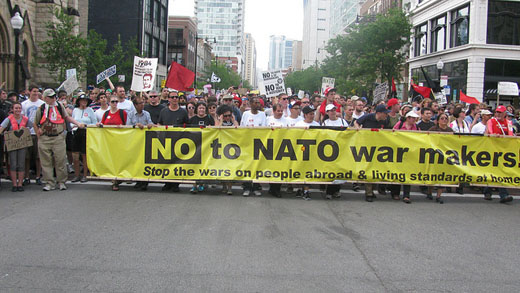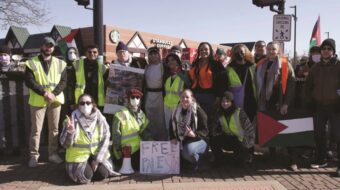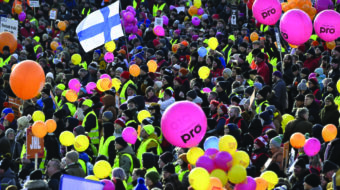
CHICAGO – One by one, they threw their medals toward the generals and statesmen behind the high barricades surrounding the NATO Summit in Chicago last week. Nearly 50 veterans made history, rejecting the lies of the 1% that justified shipping them to war in Iraq and Afghanistan.
It was one of the most profoundly moving events I have ever witnessed.
Unfortunately, their story of courage and heroism, and the largely peaceful nature of the May 20 protest and week of protests leading up to it, was buried behind headlines of violent clashes between some protesters and police.
There were in fact two protests that day: the organized mass peaceful expression – which ended with the veterans asking people to disperse peacefully – and then the confrontation with police afterward.
No one, certainly not the coalition that organized the main ceremony and march, sanctioned the confrontation and the desire by some to march through police barricades to the site of the NATO Summit.
Police violence at the demonstration and during the week, the 45 arrests and ongoing detentions, the holding at gunpoint of independent journalists who were “live streaming” the events, the alleged entrapment of several young activists on terrorism charges – all these must and are being widely condemned.
However, neither can they excuse or justify in any way the provocations that emanated from some protesters.
These incidents overshadowed the largely nonviolent nature of the protests and drowned out the main message: End the wars and militarization and reallocate desperately needed funds to create jobs and fund education, health care and affordable housing.
They especially overshadowed the veterans’ message, which has wide and deep resonance among the American people.
They also overshadowed the struggle waged for the right to protest, for free speech and assembly, and the fight against Mayor Rahm Emanuel’s “Sit Down and Shut Up” ordinances.
These experiences provide important tactical lessons for the peace and justice and Occupy movements to reflect on, especially for the many young, deeply committed activists who possess a fervent hatred of capitalism, gross inequality and injustice, and who are gaining valuable experiences in this upsurge.
Among the Occupy (and earlier anti-globalization) movements, a problematic trend has developed. That trend has a political expression, which sees confrontation with police, vandalism and hyper-aggressive tactics as its central tenets.
This trend usually manifests itself in the self-proclaimed “Black Bloc.” Its tactics here at the NATO protests, which included bullying peaceful protesters, alienated the overwhelming majority of us who marched.
Why can a small yet disruptive grouping wreak so much havoc on a majority peaceful movement? Because there is a trend among the left that also sees confrontation with the police as a viable revolutionary and anti-capitalist tactic, and therefore accommodates groups like the Black Bloc in the name of “diversity of tactics.”
It is said in the name of “inclusiveness” that those who profess confrontational tactics have a right to do so, that tactics of nonviolence and confrontation can co-exist in one movement.
Unfortunately, march organizers decided not to publicly renounce violence on the grounds of preserving unity. Instead they only spoke out against the violence the emanates from NATO and police.
Such tactics and talk may sound militant and even appear to be delivering a blow against capitalism. But, on the contrary, they play into the hands of the 1%.
Let’s be real. In order to confront ruling class power, a broad-based unified, diverse and mobilized movement among wide sections of the American people is necessary. Tactics – from the forms of protest to the kinds of demands and slogans – play a major part in mobilizing, unifying and winning over broad sections of the public.
The American people understand the use of nonviolent civil disobedience in pursuit of a great cause and high moral purpose. It is an indelible part of our multi-racial, working-class history of struggle.
But they are equally turned off when violence is perpetrated or advocated by those who profess change.
Such tactics do nothing to expand the coalition or build the movement for immediate or long-term change.
They do damage by feeding into ruling class crackdowns, including anti-democratic laws and statutes.
It was the specter of violence that Chicago Mayor Emanuel used effectively to gain passage of restrictions on First Amendment rights.
Certainly, there should be no illusions about the role of the police as an institution, let alone the history of brutality of the Chicago Police Department.
But neither should one ignore how ruling circles and authorities have exploited a permissive attitude toward violence to infiltrate and entrap, to provoke violent acts that split groups or narrow movements, driving away the broader political allies needed for victory.
Such tactics ultimately spell doom for any movement. The upsurge of the 1960s is replete with examples including the destruction of groups and tragic death of many young activists like Black Panther Fred Hampton.
The most powerful mass movements effecting historic change have been based on nonviolent civil disobedience: the civil rights movement led by Dr. Martin Luther King; the anti-Vietnam War movement; the U.S. anti-apartheid struggle and the organization of industrial unions, to name a few.
More recently, nonviolent civil disobedience has effectively won public support for workers and immigrant rights and saving the environment. It forced the racist murder of Trayvon Martin into the national spotlight.
The aim of any tactic must be to build a majority movement of the most powerful class and social forces capable of winning. The value of a tactic can be determined in how well it achieves this.
Any tolerance for violence, provocation or confrontation is a political dead end.












Comments